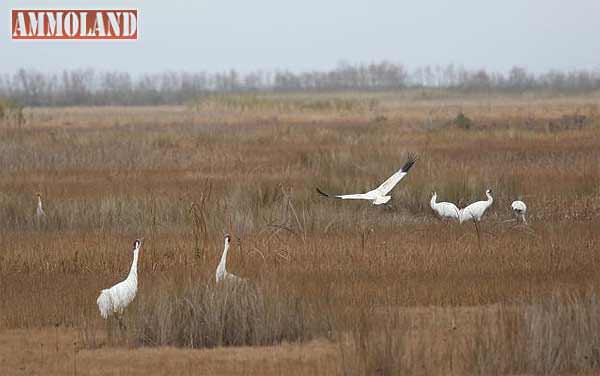

Lincoln, Neb -(Ammoland.com)-The entire population of whooping cranes in the Central Flyway is expected to migrate through Nebraska over the next several weeks. Conservation entities encourage the public to report whooping crane sightings.
Information on sightings is used individually and collectively by Nebraska Game and Parks Commission, U.S. Fish and Wildlife Service, The Crane Trust and the Platte River Recovery Implementation Program to positively affect whooping crane conservation and recovery efforts.
Individuals should report whooping crane sightings by contacting Game and Parks at 402-471-0641 or joel.jorgensen@nebraska.gov, the U.S. Fish and Wildlife Service at 308-382-6468, ext. 205, or the Crane Trust Whooper Watch hotline at 1-888-3WWATCH (1-888-399-2824). Observers are encouraged to record number of birds, location, type of activity, and number of adults and juveniles, and then report the sighting so it can be verified.
Observers are reminded that other common species occasionally are mistaken for whooping cranes. Sandhill crane, American white pelican, great blue heron, trumpeter swan and snow goose are regularly reported as whooping cranes. Whooping cranes are approximately 5 feet tall and fly with their neck outstretched. Adults are all white with the exception of black wing tips and reddish-black facial pattern.
Whooping cranes that migrate through the Central Flyway are often referred to as the Aransas-Wood Buffalo flock. Cranes from this population migrate, generally in small groups, from wintering sites at and around Aransas National Wildlife Refuge in Texas to breeding sites at and around Wood Buffalo National Park in Alberta.
In the early to mid-20th century, this population was reduced to fewer than 20 individuals and was perilously close to extinction. As a result of legal protection, such as the Endangered Species Act and the Nebraska Nongame and Endangered Species Conservation Act, and conservation efforts, whooping crane numbers have slowly increased. Surveys conducted in Texas this past winter by the U.S. Fish and Wildlife Service shows there are approximately 300 whooping cranes in the Aransas-Wood Buffalo flock.
Whooping cranes should not be approached. Harassing whooping cranes may put them at risk, and it also is a violation of state and federal law. Individuals should observe these birds from a distance, preferably in a vehicle, so their actions do not change a whooping crane’s behavior.
